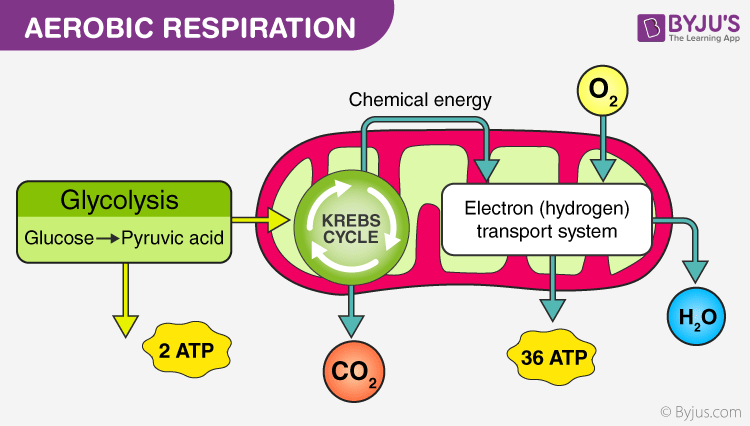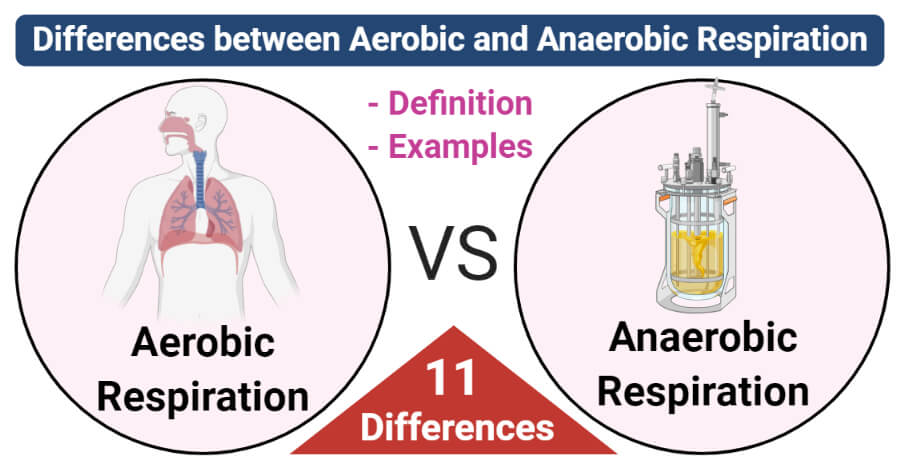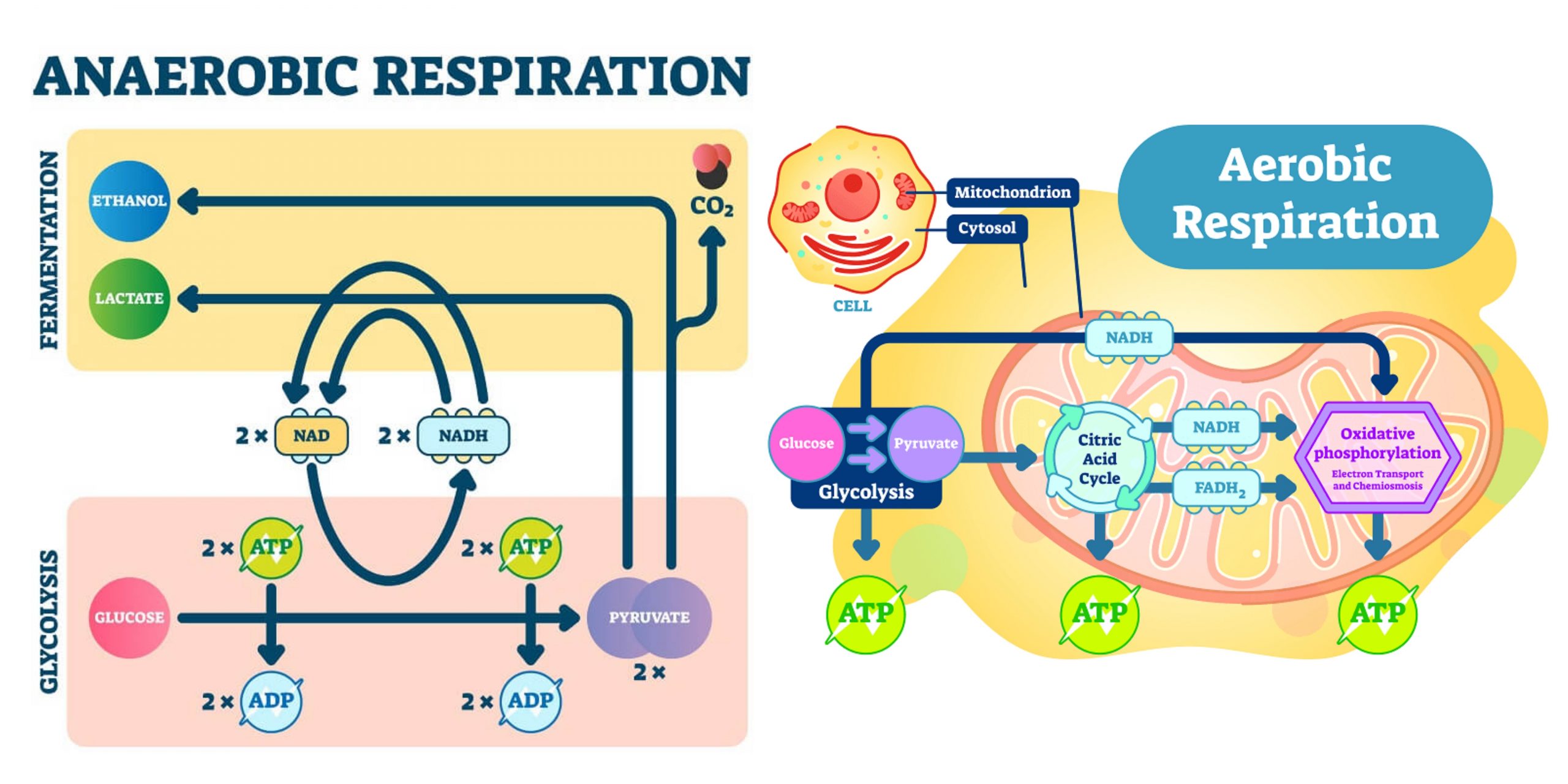Explain the Major Differences Between Aerobic and Anaerobic Energy Production.
Continuous steady state exercise is performed aerobically. The difference between them is.

Aerobic And Anaerobic Respiration Major Differences
Anaerobic respiration occurs mostly in prokaryotes.

. Glucose oxygen - carbon dioxide water. Aerobic respiration is more efficient than. Amount of energy released.
When observing anaerobic vs. Tap card to see definition. Aerobic respiration requires oxygen whereas anaerobic respiration takes place in the absence of oxygen.
Use the worksheets below to collect your data. Both aerobic and anaerobic exercise can be great additions to your workout routine. Aerobic fermentation occurs in the living organisms.
Aerobic means with air and refers to the body producing energy with the use of oxygen. Oxygen is your main energy source during aerobic workouts. Immediate anaerobic energy system and.
As we touched on the main difference between aerobic and anaerobic respiration is whether or not oxygen is present. On the flip side anaerobic fermentation occurs outside the living organisms body. How your metabolism works depends on the type of exercise youre doing at the time.
Anaerobic respiration also produces energy and uses glucose but it produces less. Furthermore the aerobic process is more efficient in the production of energy in the form of ATP while anaerobic process is less efficient in the. In aerobic training it comes from oxygen and energy stored in carbs proteins and fats.
During aerobic exercise you. This is typically exercise that is performed. Our bodies can create anaerobic energy in two ways through the.
However aerobic respiration produces much more energy or ATP molecules than anaerobic respiration. Aerobic Anaerobic fermentation and Anaerobic fermentation both. For every molecule of glucose that is metabolized in the presence of oxygen by aerobic respiration 38 ATP molecules are produced.
Aerobic respiration occurs in the cytoplasm to mitochondria while anaerobic respiration occurs in the cytoplasm only. Short-term anaerobic energy system. As a result of training anaerobic threshold increases and VO 2MAX increases.
The electron transfer chain therefore stops working and no further ATP is formed by. Explain the major differences between aerobic and anaerobic energy production. The similarities and differences between aerobic and anaerobic respiration are as follows.
Aerobic respiration takes place in the mitochondria. Aerobic and anaerobic bacteria are the two groups of bacteria classified based on the type of respiration. In anaerobic respiration also energy is produced by the breakdown of food like glucose.
The main difference between aerobic and anaerobic bacteria is that anaerobic bacteria use molecular oxygen as the final electron acceptor in the electron transport chain whereas anaerobic bacteria use other molecules or compounds as the final electron. This typically involves any exercise that lasts longer than two minutes in duration. Aerobic fermentation is an energy production method.
Similarities and differences between aerobic and anaerobic respiration Cellular respiration is a process that takes place inside the cells where the breakdown of glucose molecules releases energy. Your respiration and heart rate differ in aerobic activities versus anaerobic ones. Metabolism is the most basic job your body must complete in order to survive and function.
The high amount of energy is produced and 38 ATP released at a time in aerobic respiration. Aerobic respiration takes place in the mitochondria and requires oxygen and glucose and produces carbon dioxide water and energy. Differences of Aerobic Anaerobic Exercises on the Metabolism.
Anaerobic fermentation has no glycolysis or other stages. The enzymes used are catalase peroxidase and superoxide dismutase. In anaerobic respiration when free oxygen is not present hydrogen cannot be disposed of by combination with oxygen.
2 The immediate anaerobic energy system. Oxygen is your main energy source during aerobic workouts. Anaerobic fermentation does not use oxygen.
The chemical equation is C_6H_ 12O_66O_2 Rightarrow 6CO_26H_2O38ATP. Thus the longer the exercise is the more important aerobic respiration becomes. Stages include Glycolysis Krebs cycle and electron transport system.
Anaerobic respiration also utilizes glycolysis to break down glucose. The main difference between aerobic and anaerobic process is that in an aerobic process molecular oxygen occurs inside the cell whereas in an anaerobic process molecular oxygen is absent inside the cell. Define anaerobic threshold and explain the physiological changes that occur as a result of training Hint.
The main difference between anaerobic and aerobic exercise is how intense the activity is aerobic has a lower intensity while anaerobic has a higher intensity. On the other hand anaerobic bacteria yeast cells prokaryotes and muscle cells perform anaerobic respiration. What is the difference between Aerobic and Anaerobic Fermentation.
Aerobic fermentation uses oxygen. Neither system provides sustainable energy for very long. However because there is no oxygen present ATP must be generated in the cytoplasm via fermentation.
Less amount of energy is produced and 2 ATP are released at a time in anaerobic respiration. Anaerobic means without air and refers to the body producing energy without oxygen. They have anaerobic methods of energy production.
The two types of exercise also have differences when it comes to benefits. Aerobic microorganisms use glycolysis the Krebs TCA cycle and an electron transport chain with oxygen as the final electron acceptor. Based on the oxygen usage the process can be conveniently divided into two categories namely aerobic and anaerobic respiration.
The aerobes use oxygen when it is available but are not solely reliant on it. Aerobic fermentation is a type of reaction that causes the production of energy by completely decomposing the food while anaerobic fermentation is the chemical process of biological compounds. Both aerobic and anaerobic respiration use electron-transport chain-reaction pathways in energy production.
Oxygen is present in aerobic respiration as the final electron acceptor where an electron and a proton are transferred to oxygen reducing it to water. Anaerobic fermentation does not produce ATP molecules. Anaerobic threshold is when your body is exerted to the point where it has to switch from aerobic to anaerobic metabolism to provide the energy needed.
Anaerobic means without oxygen. Anaerobic fermentation is a decomposition method. There are two types of exercise aerobic and anaerobic.
Define anaerobic threshold and explain the physiological changes that occur as a result of training. They each provide health benefits and help keep you physically fit. Aerobic exercise energy in anaerobic training comes from muscles.
Aerobic respiration needs oxygen to occur while anaerobic does not. Most of the plant and animal cells use aerobic respiration. The anaerobic energy system is the energy system of choice for the 100m sprinter.

Aerobic Vs Anaerobic Respiration Definition 11 Differences Examples

Difference Between Aerobic And Anaerobic Respiration Aerobic Vs Anaerobic Respiration

Aerobic Vs Anaerobic Respiration Venn Diagram Cellular Respiration Venn Diagram Anaerobic Respiration
No comments for "Explain the Major Differences Between Aerobic and Anaerobic Energy Production."
Post a Comment